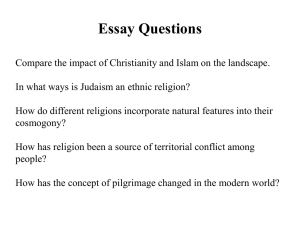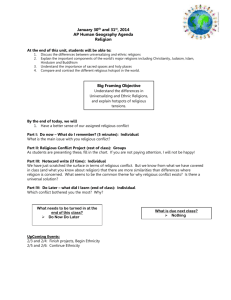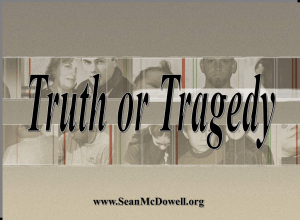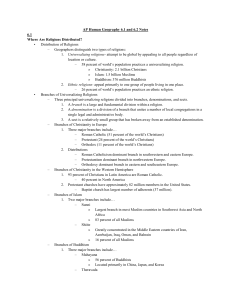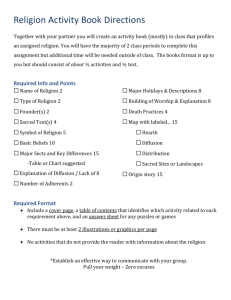File
advertisement
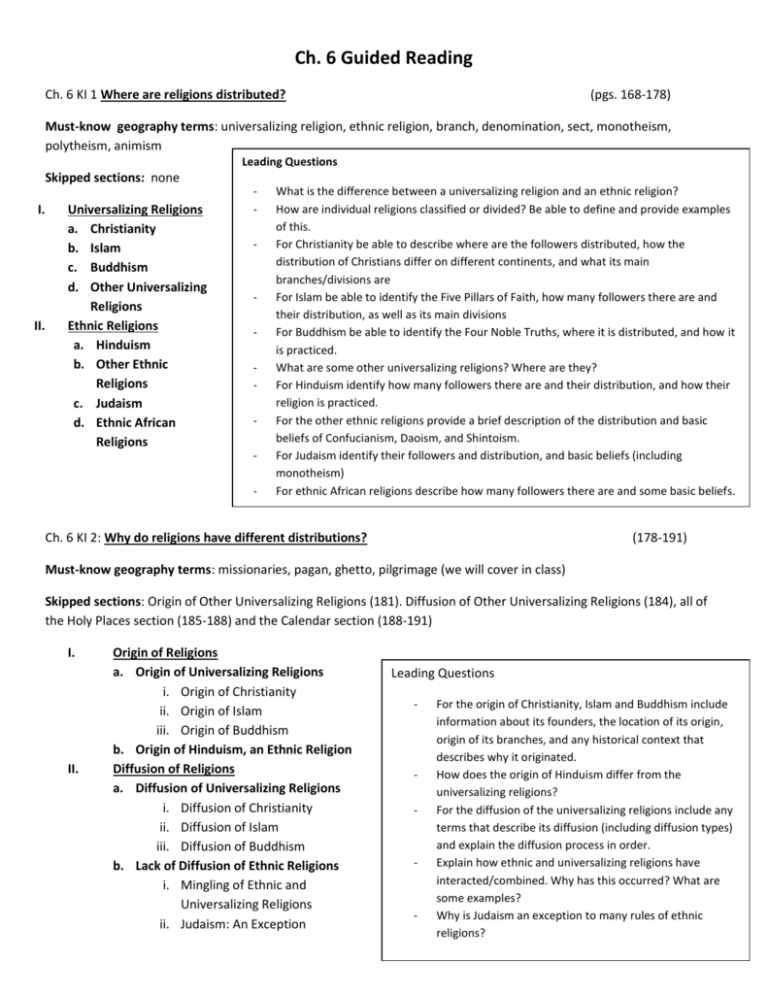
Ch. 6 Guided Reading Ch. 6 KI 1 Where are religions distributed? (pgs. 168-178) Must-know geography terms: universalizing religion, ethnic religion, branch, denomination, sect, monotheism, polytheism, animism Leading Questions Skipped sections: none I. II. Universalizing Religions a. Christianity b. Islam c. Buddhism d. Other Universalizing Religions Ethnic Religions a. Hinduism b. Other Ethnic Religions c. Judaism d. Ethnic African Religions - - What is the difference between a universalizing religion and an ethnic religion? How are individual religions classified or divided? Be able to define and provide examples of this. For Christianity be able to describe where are the followers distributed, how the distribution of Christians differ on different continents, and what its main branches/divisions are For Islam be able to identify the Five Pillars of Faith, how many followers there are and their distribution, as well as its main divisions For Buddhism be able to identify the Four Noble Truths, where it is distributed, and how it is practiced. What are some other universalizing religions? Where are they? For Hinduism identify how many followers there are and their distribution, and how their religion is practiced. For the other ethnic religions provide a brief description of the distribution and basic beliefs of Confucianism, Daoism, and Shintoism. For Judaism identify their followers and distribution, and basic beliefs (including monotheism) For ethnic African religions describe how many followers there are and some basic beliefs. Ch. 6 KI 2: Why do religions have different distributions? (178-191) Must-know geography terms: missionaries, pagan, ghetto, pilgrimage (we will cover in class) Skipped sections: Origin of Other Universalizing Religions (181). Diffusion of Other Universalizing Religions (184), all of the Holy Places section (185-188) and the Calendar section (188-191) I. II. Origin of Religions a. Origin of Universalizing Religions i. Origin of Christianity ii. Origin of Islam iii. Origin of Buddhism b. Origin of Hinduism, an Ethnic Religion Diffusion of Religions a. Diffusion of Universalizing Religions i. Diffusion of Christianity ii. Diffusion of Islam iii. Diffusion of Buddhism b. Lack of Diffusion of Ethnic Religions i. Mingling of Ethnic and Universalizing Religions ii. Judaism: An Exception Leading Questions - - - - For the origin of Christianity, Islam and Buddhism include information about its founders, the location of its origin, origin of its branches, and any historical context that describes why it originated. How does the origin of Hinduism differ from the universalizing religions? For the diffusion of the universalizing religions include any terms that describe its diffusion (including diffusion types) and explain the diffusion process in order. Explain how ethnic and universalizing religions have interacted/combined. Why has this occurred? What are some examples? Why is Judaism an exception to many rules of ethnic religions? Ch. 6 KI 3 Why do religions organize space in distinctive patterns? NOTE: we will not take typical reading notes for this section; the information will be recorded on a worksheet that is to be passed out in class. Ch. 6 KI 4: Why do territorial conflicts arise among religious groups? Skipped sections: Must know geography terms: I. Religion Versus Government Policies a. Religion Versus Social Change i. Taliban Versus Western Values ii. Hinduism Versus Social Equality b. Religion Versus Communism i. Orthodox Christianity and Islam Versus the USSR ii. Buddhism Versus Southeast Asian Countries Religion Versus Religion a. Religious Wars in Ireland b. Religious Wars in the Middle East i. Crusades Between Christians and Muslims ii. Jews Versus Muslims in Palestine 1. Jerusalem: Contested Geography (case study on page 198) 2. Conflict over the Holy Land: Palestinian Perspective 3. Conflict over the Holy Land: Israeli Perspective 4. Building a Barrier in the Middle East (Case Study pg. 202) II. Leading Questions - - Why would religions conflict with a government? For the Taliban section and the Hinduism section be able to describe the conflict as well as the causes and effects of the conflict. For the Orthodox Christianity/Islam versus USSR and the Buddhism example be able to describe why communism conflicts with religion and what the communists have done or not done to cause these problems. What is fundamentalism? How does it cause conflict? Summarize the causes and effects of the religious wars in Ireland. What three religions are dominant in the Middle East? Why? Explain the causes and effects of the Crusades. Why do Jews and Muslims conflict in Palestine? Summarize the main idea of the case study on Jerusalem. What is the Palestinian perspective on the conflict? Who is considered a Palestinain? What is the Israeli perspective on the conflict? What is the green line? What is being built there? What has been the effect?
